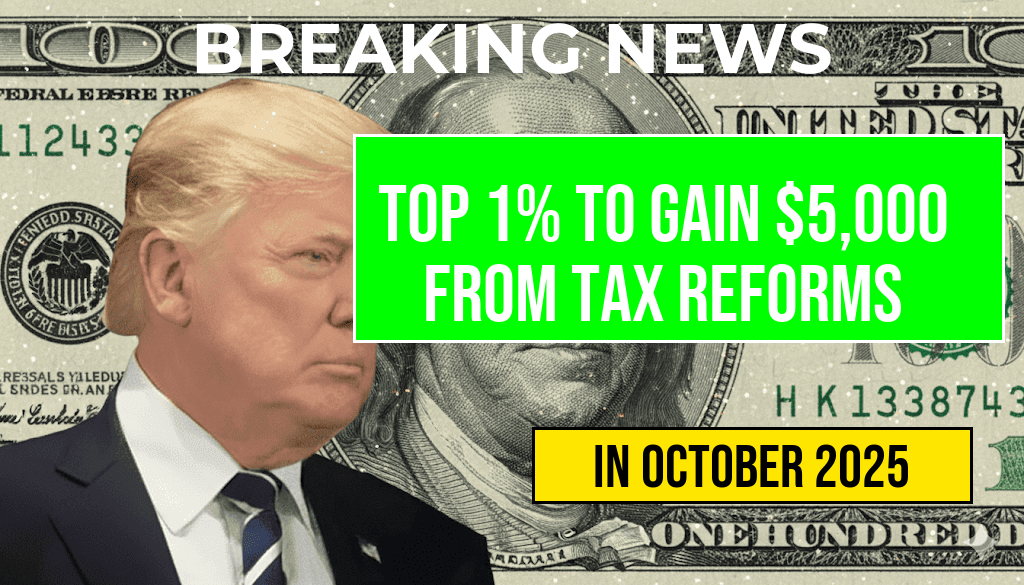Recent analyses project that the wealthiest Americans within the top 1% are set to see an average increase of approximately $5,000 in net income due to recent tax reforms. This shift stems from a combination of legislative adjustments aimed at altering tax rates, deductions, and credits that predominantly benefit high-income households. While the reforms are touted by proponents as a step toward simplifying the tax code and fostering economic growth, critics argue they may widen income disparities. The projected income boost highlights ongoing debates about how tax policies influence wealth concentration and fiscal equity in the United States.
Understanding the Scope of the Tax Reforms
The recent legislative changes introduced by Congress encompass several modifications to the existing tax code. These include adjustments to marginal income tax rates, revisions to capital gains taxation, and alterations to estate taxes. The reforms aim to create a more streamlined tax system while incentivizing investment and economic activity among high-net-worth individuals. According to analyses from the U.S. Congress, the reforms primarily benefit taxpayers with annual incomes exceeding $1 million, with the top 0.1% experiencing the most significant gains.
Projected Income Gains for the Top 1%
| Income Bracket | Average Net Income Gain |
|---|---|
| Top 0.1% | $12,000 |
| Top 0.5% | $7,500 |
| Top 1% | $5,000 |
This data, compiled by economic research firms and tax policy analysts, indicates that the highest earners are positioned to benefit disproportionately from these changes. Factors contributing to this include reductions in capital gains taxes and modifications in estate transfer rules, which tend to favor those with substantial wealth holdings invested in assets such as stocks, bonds, and real estate.
Factors Driving the Income Increase
Capital Gains Tax Adjustments
One of the most impactful elements of the reforms is the lowering of capital gains tax rates for high-income earners. The rate on long-term capital gains has been reduced from 20% to 15% for many taxpayers in the top bracket, which directly increases after-tax income for investors holding significant portfolios. This change is expected to result in increased gains upon asset sales, boosting overall net income for wealthy households.
Estate and Gift Tax Revisions
Another component involves raising the estate tax exemption threshold, allowing wealthy individuals to transfer larger estates without incurring federal taxes. The exemption increased from approximately $11 million to roughly $12 million per individual, enabling heirs to inherit more without facing tax burdens. This adjustment effectively preserves wealth within high-net-worth families, contributing to the overall income gains observed among the top 1%.
Tax Rate Structures and Deductions
Changes to marginal income tax brackets and the elimination of certain deductions have also played a role. While some middle-income taxpayers face increased rates or phased-out deductions, high earners benefit from maintaining or even expanding certain preferential treatments, resulting in net income improvements.
Implications and Criticisms
While proponents argue that these reforms foster economic growth by incentivizing investment and entrepreneurship, critics contend they exacerbate wealth inequality. The Forbes editorial board points out that such policies tend to favor the already affluent, potentially leading to a broader wealth gap. Economists also caution that increased after-tax income for the top 1% may not translate into proportional benefits for the broader economy or middle-class households.
Broader Economic Context
Tax policy shifts occur within a complex economic landscape shaped by global markets, fiscal deficits, and political priorities. The projected $5,000 increase in net income for the wealthiest Americans is part of a larger debate about balancing fiscal responsibility with social equity. Some analysts suggest that, although the reforms may boost the income of high earners, they could also result in reduced government revenue, potentially impacting public spending on services that benefit all citizens.
References
Frequently Asked Questions
What is the main focus of the recent tax reforms?
The recent tax reforms are expected to impact the wealthiest Americans in the Top 1%, primarily resulting in an estimated $5,000 increase in their net income.
How much net income are the top 1% of earners projected to gain?
The top 1% of Americans are projected to gain approximately $5,000 in net income due to the tax reforms.
Which groups of Americans are most affected by the tax reforms?
The wealthiest Americans, specifically those in the top 1%, are the primary groups affected, experiencing the largest income gains from the reforms.
Are the benefits of the tax reforms evenly distributed across all income groups?
No, the benefits of the tax reforms are expected to be concentrated among the wealthiest Americans, with higher net income gains for those in the top 1%.
What is the significance of this income increase for the wealthy?
The estimated $5,000 increase in net income highlights how the tax reforms may further accentuate economic disparities, benefitting the wealthiest Americans significantly.





